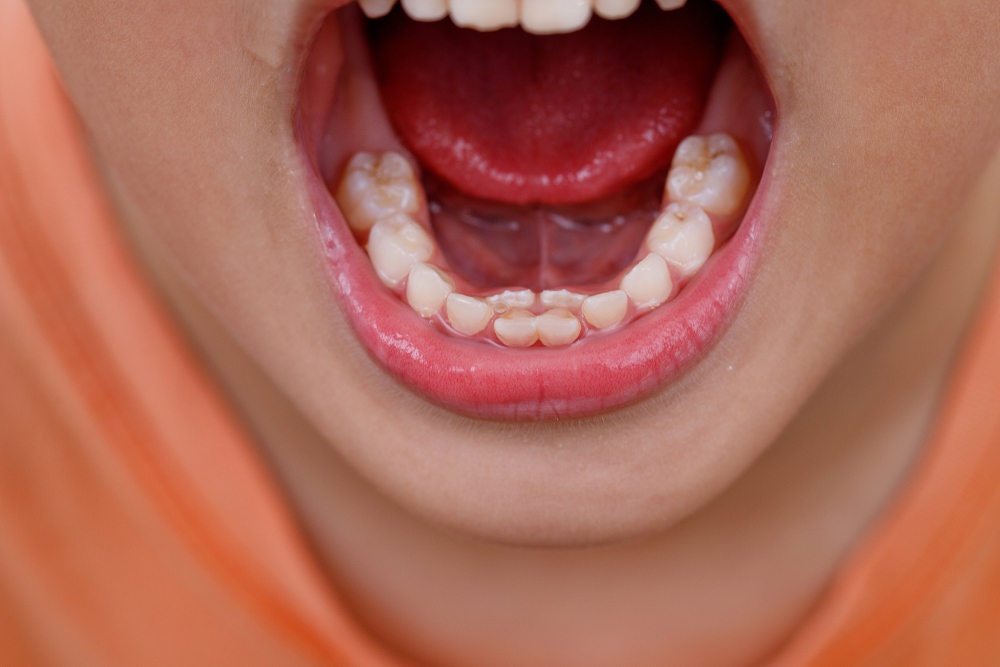A peculiar dental condition known as shark teeth is gaining increased attention from parents and pediatric health care professionals across the United States as more families encounter the startling sight of adult teeth emerging behind existing baby teeth. The phenomenon, while typically harmless, has prompted thousands of concerned parents to seek professional dental consultations when their children develop what appears to be double rows of teeth.
Pediatric dentists report growing awareness of this condition, which occurs when permanent teeth begin erupting before baby teeth have properly loosened and fallen out naturally. The resulting appearance resembles shark dentition, where multiple rows of teeth exist simultaneously within the mouth, creating concern among parents who may be witnessing this developmental variation for the first time.
The condition typically affects children around age 6 when the natural tooth replacement process begins, though individual developmental timelines can vary significantly based on genetic factors and overall oral health care circumstances.
Natural tooth development process faces complications
The normal tooth replacement sequence involves adult teeth pushing through gum tissue while simultaneously causing baby tooth roots to dissolve, facilitating the natural loosening and eventual loss of primary teeth. However, this coordinated process occasionally encounters disruptions that result in shark teeth formation.
Dental professionals explain that root dissolution may occur incompletely, preventing baby teeth from loosening adequately to accommodate emerging permanent teeth. Additionally, adult teeth may erupt at unusual angles that bypass baby teeth entirely, creating the characteristic double-row appearance that concerns many parents.
The front teeth typically begin the replacement process first, progressing systematically toward the back of the mouth over several years. This sequential pattern means that shark teeth most commonly affect the lower front incisors, though the condition can occur anywhere in the mouth where primary and permanent teeth coexist.
Professional intervention addresses persistent cases
While many shark teeth situations resolve naturally through continued tooth development, some cases require professional pediatric dental intervention to prevent potential complications. Dentists recommend monitoring the condition for approximately two months before considering active treatment approaches.
Persistent baby teeth that refuse to loosen despite the presence of emerging adult teeth may require extraction to prevent overcrowding and alignment issues. Dental professionals can safely remove stubborn primary teeth, allowing permanent teeth adequate space for proper positioning within the dental arch.
Early intervention helps prevent secondary complications including tooth misalignment, overcrowding, and increased difficulty maintaining proper oral hygiene around irregularly positioned teeth. These preventive measures support long-term dental health care and reduce the likelihood of requiring extensive orthodontic treatment later.
Home management strategies support natural resolution
Parents can encourage natural resolution of shark teeth situations through gentle intervention techniques that promote baby tooth loosening. Encouraging children to wiggle loose teeth helps accelerate the natural shedding process while maintaining their engagement in their oral health care routine.
Dietary modifications including crunchy foods like apples and carrots can provide natural pressure that helps loosen stubborn baby teeth. However, parents should avoid excessive force or aggressive manipulation that could damage developing permanent teeth or cause unnecessary discomfort.
Enhanced oral hygiene routines become particularly important when shark teeth are present, as the irregular tooth positioning can create challenging areas for effective brushing and flossing. Specialized pediatric dental tools and techniques may be necessary to maintain proper oral health care during this transitional period.
Long-term outlook remains positive for affected children
The vast majority of shark teeth cases resolve without lasting complications, with permanent teeth eventually achieving proper positioning once baby teeth are removed or fall out naturally. Regular pediatric dental monitoring ensures that any developing issues receive prompt attention before becoming significant problems.
Most children experience minimal discomfort during the shark teeth phase, though some may report mild pressure or unusual sensations as their dental development progresses.


















